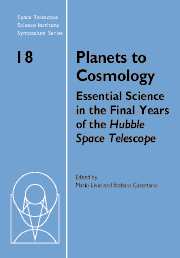 Planets to Cosmology
Planets to Cosmology Book contents
- Frontmatter
- Contents
- Participants
- Preface
- Hubble's view of transiting planets
- Unsolved problems in star formation
- Star formation in clusters
- HST abundance studies of low metallicity stars
- Physical conditions and feedback: HST studies of intense star-forming environments
- Quasar hosts: Growing up with monstrous middles
- Reverberation mapping of active galactic nuclei
- Feedback at high redshift
- The baryon content of the local intergalactic medium
- Hot baryons in supercluster filaments
- Galaxy assembly
- Probing the reionization history of the Universe
- Studying distant infrared-luminous galaxies with Spitzer and Hubble
- Galaxies at z ≈ 6–i′-drop selection and the GLARE Project
- The Hubble Ultra Deep Field with NICMOS
Galaxy assembly
Published online by Cambridge University Press: 17 August 2009
- Frontmatter
- Contents
- Participants
- Preface
- Hubble's view of transiting planets
- Unsolved problems in star formation
- Star formation in clusters
- HST abundance studies of low metallicity stars
- Physical conditions and feedback: HST studies of intense star-forming environments
- Quasar hosts: Growing up with monstrous middles
- Reverberation mapping of active galactic nuclei
- Feedback at high redshift
- The baryon content of the local intergalactic medium
- Hot baryons in supercluster filaments
- Galaxy assembly
- Probing the reionization history of the Universe
- Studying distant infrared-luminous galaxies with Spitzer and Hubble
- Galaxies at z ≈ 6–i′-drop selection and the GLARE Project
- The Hubble Ultra Deep Field with NICMOS
Summary
In a ΛCDM Universe, galaxies grow in mass both through star formation and through the addition of already-formed stars in galaxy mergers. Because of this partial decoupling of these two modes of galaxy growth, I discuss each separately in this biased and incomplete review of galaxy assembly—first giving an overview of the cosmic-averaged star formation history, and then moving on to discuss the importance of major mergers in shaping the properties of present-day massive galaxies. The cosmic-averaged star-formation rate, when integrated, is in reasonable agreement with the build-up of stellar mass density. Roughly 2/3 of all stellar mass is formed during an epoch of rapid star formation prior to z ∼ 1, with the remaining 1/3 formed in the subsequent 9 Gyr during a period of rapidly-declining star-formation rate. The epoch of important star formation in massive galaxies is essentially over. In contrast, a significant fraction of massive galaxies undergo a major merger at z ≲ 1, as evidenced by close-pair statistics, morphologically-disturbed galaxy counts, and the build-up of stellar mass in morphologically early-type galaxies. Each of these methods is highly uncertain; yet, taken together, it is not implausible that the massive galaxy population is strongly affected by late galaxy mergers, in excellent qualitative agreement with our understanding of galaxy evolution in a ΛCDM Universe.
Introduction
The last decade has witnessed amazing progress in our empirical and theoretical understanding of galaxy formation and evolution.
- Type
- Chapter
- Information
- Planets to CosmologyEssential Science in the Final Years of the Hubble Space Telescope: Proceedings of the Space Telescope Science Institute Symposium, Held in Baltimore, Maryland May 3–6, 2004, pp. 137 - 156Publisher: Cambridge University PressPrint publication year: 2006
- 1
- Cited by


